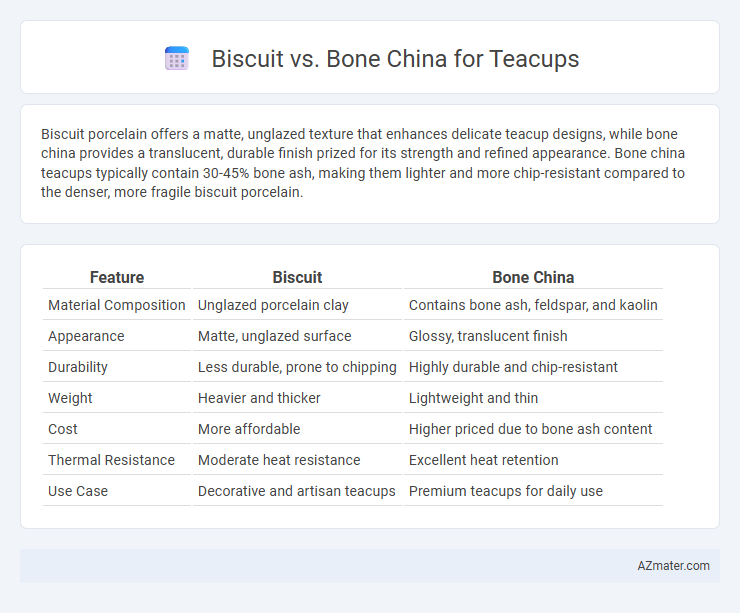Biscuit porcelain offers a matte, unglazed texture that enhances delicate teacup designs, while bone china provides a translucent, durable finish prized for its strength and refined appearance. Bone china teacups typically contain 30-45% bone ash, making them lighter and more chip-resistant compared to the denser, more fragile biscuit porcelain.
Table of Comparison
| Feature | Biscuit | Bone China |
|---|---|---|
| Material Composition | Unglazed porcelain clay | Contains bone ash, feldspar, and kaolin |
| Appearance | Matte, unglazed surface | Glossy, translucent finish |
| Durability | Less durable, prone to chipping | Highly durable and chip-resistant |
| Weight | Heavier and thicker | Lightweight and thin |
| Cost | More affordable | Higher priced due to bone ash content |
| Thermal Resistance | Moderate heat resistance | Excellent heat retention |
| Use Case | Decorative and artisan teacups | Premium teacups for daily use |
Introduction: Understanding Biscuit and Bone China
Biscuit and bone china are two popular materials used in crafting teacups, each offering distinct qualities and characteristics. Biscuit, also known as bisque, is unglazed porcelain that has a matte finish and a more porous texture, offering a delicate and vintage appeal. Bone china contains bone ash, providing exceptional strength, translucency, and a smooth, glazed surface that enhances durability and elegance in teacup design.
What is Biscuit China?
Biscuit china, also known as bisque porcelain, is an unglazed, matte-finished ceramic that resembles the texture of bisque dolls and offers a soft, porcelain-white appearance. Unlike bone china, which contains bone ash for enhanced strength and translucency, biscuit china emphasizes a smooth, chalky surface ideal for decorative teacups and collectible items. Its porous texture allows for a unique tactile experience, often preferred by collectors valuing aesthetic and artisanal qualities over the glossy finish of traditional bone china teacups.
What is Bone China?
Bone china is a type of porcelain known for its high strength, whiteness, and translucency, achieved by adding bone ash to the clay mixture. This composition results in delicate yet durable teacups, prized for their elegance and resistance to chipping compared to other ceramics. Biscuit, or unglazed china, contrasts bone china by showcasing a matte, porous finish without the glossy protective layer.
Manufacturing Processes Compared
Biscuit china undergoes a firing process without any glaze, resulting in a matte, porous finish that highlights the fine texture of the porcelain. Bone china is crafted using bone ash mixed with kaolin and feldspar, fired at higher temperatures, and finished with a translucent glaze that enhances durability and smoothness. The manufacturing of bone china demands precise temperature control for vitrification, whereas biscuit china emphasizes maintaining the raw, unglazed surface through careful kiln firing.
Texture and Finish Differences
Biscuit porcelain exhibits a matte, unglazed texture that emphasizes a soft, velvety finish with a slightly porous surface, enhancing its tactile appeal. Bone china features a smooth, glossy finish due to its high level of vitrification and glaze, resulting in a translucent and polished appearance. The textured contrast between biscuit's raw, natural feel and bone china's refined, shiny surface significantly influences the sensory experience of teacup use and aesthetics.
Durability and Practical Use
Biscuit teacups, made from unglazed porcelain, offer a matte finish but are generally more fragile and prone to chipping compared to bone china teacups. Bone china, composed of bone ash, feldspar, and kaolin, provides superior durability and resistance to thermal shock, making it ideal for everyday use and frequent washing. Its translucent quality and strength ensure practical elegance without compromising long-term functionality.
Aesthetic Appeal: Color and Design
Biscuit porcelain teacups are prized for their matte, unglazed finish that highlights intricate textures and delicate patterns with a soft, muted color palette. Bone china teacups offer a smooth, glossy surface with a translucent quality and vibrant, often hand-painted designs that emphasize elegance and refinement. The choice between biscuit and bone china for teacups depends on whether one prefers a subtle, natural look or a polished, luminous aesthetic rich in detail.
Cost and Value Considerations
Biscuit teacups, known for their unglazed, matte finish, generally cost less than bone china due to simpler production processes and lower material expenses. Bone china teacups offer superior durability, translucency, and a higher-quality aesthetic, which justifies their higher price point and enhances long-term value for collectors and everyday users. Choosing between biscuit and bone china teacups depends on prioritizing budget constraints versus investment in lasting elegance and refined craftsmanship.
Popular Uses in Teacups
Biscuit porcelain is favored for teacups due to its unglazed, matte finish that provides a smooth, elegant texture ideal for delicate tea rituals. Bone china remains popular for teacups because of its high strength, translucency, and chip resistance, making it perfect for everyday use and formal occasions. Collectors and tea enthusiasts often choose bone china for its refined appearance and durability, while biscuit porcelain appeals to those seeking a more artisanal, textured feel.
Choosing the Best Material for Your Teacup
Biscuit porcelain offers a matte, unglazed finish that highlights fine details and adds a delicate, classical aesthetic to teacups, making it ideal for collectors and those valuing intricate artistry. Bone china features high durability, a translucent quality, and a smooth glazed surface, providing a refined look and practical resistance to chipping, perfect for everyday use. Selecting the best material depends on the balance between aesthetic preference, durability needs, and intended teacup usage, with bone china favored for functionality and biscuit chosen for decorative appeal.

Infographic: Biscuit vs Bone China for Teacup
 azmater.com
azmater.com